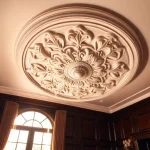Seamlessly Enhancing Audio in Traditional UK Homes
Successfully integrating a modern audio system within traditional UK interiors demands thoughtful planning around heritage and period design elements. Many older homes feature solid walls and intricate woodwork, which can challenge installation but also offer unique opportunities for discreet equipment placement.
A significant factor influencing audio system integration is preserving the original character of the home. Well-chosen solutions balance cutting-edge sound quality with minimal visual impact. For instance, in Georgian or Victorian homes, flush-mounted or slim-profile speakers complement decorative moldings without detracting from historical features.
In the same genre : Transform your home with stunning victorian ceiling roses
Beyond aesthetics, upgrading audio in period spaces delivers impressive benefits. Homeowners enjoy immersive sound experiences for music or films without compromising on style. Modern audio technology allows for multi-room setups where speakers blend seamlessly into different rooms, maintaining the home’s traditional atmosphere.
Different UK home styles bring varying implications for audio setups. Edwardian properties often value ceiling-mounted systems to avoid wall damage, while cottages prioritize wireless options to minimize invasive wiring. Understanding these nuances ensures the perfect blend of modern audio technology with timeless home design.
Have you seen this : Upgrade your space with stylish frosted window films for privacy
Strategic Audio System Choices for Timeless Environments
Choosing the best audio systems for traditional UK homes involves prioritizing both sound quality and visual subtlety. For period interiors, discreet speakers such as in-wall or in-ceiling models work well, ensuring the system complements, rather than competes with, vintage architectural features. These speakers blend with cornices or ceiling roses, preserving the home’s character.
Multi-room systems offer flexible control, allowing homeowners to enjoy music seamlessly in multiple rooms while maintaining a clean appearance. Brands specializing in heritage-friendly audio technology emphasize slim profiles and custom finishes that match woodwork or plaster. For example, wireless connectivity reduces the need for visible wiring, an advantage in older homes where invasive installation is undesirable.
Selecting equipment requires balancing aesthetic harmony with acoustic performance. Tube amplifiers or warm-sounding speaker designs can also appeal, as their tonal qualities suit the ambiance of many classic UK interiors. Sound professionals often recommend systems that support expansion, giving users the freedom to upgrade or add components with minimal fuss.
In sum, the right choices create immersive soundscapes while honoring the timeless beauty of period homes—demonstrating that modern audio technology and vintage home audio can coexist elegantly.
Design Considerations for Maintaining Aesthetic Harmony
When integrating modern audio technology into period interiors, preserving the charm of traditional home design is paramount. Careful audio design tips focus on blending components seamlessly without compromising character. For instance, concealed audio solutions like in-wall or in-ceiling speakers are effective in minimizing visual disruption while delivering quality sound.
A frequent challenge in UK interiors is managing wiring through solid walls common in older homes. Proper cable routing and cable management techniques avoid damage to plasterwork and woodwork. Using wireless or low-profile cabling methods respects the structural integrity and decorative details, ensuring the installation remains discreet.
In spaces featuring elaborate cornices or ceiling roses, discreet placement around these features helps maintain aesthetic balance. Specialists often recommend mounting speakers behind decorative grilles that match the room’s colours or textures. This approach preserves the historical ambiance while benefiting from state-of-the-art sound performance.
Additionally, integrating subwoofers or amplifiers into furniture or bespoke cabinetry supports a tidy appearance. Such careful planning achieves a harmonious synthesis where period decor meets cutting-edge audio system integration—enhancing both the auditory experience and visual appeal of UK traditional homes.
Expert Installation and Acoustic Optimization
Achieving superior sound quality in traditional UK homes demands professional audio installation tailored to the unique challenges of heritage properties. Experts familiar with UK acoustics effectively address common issues such as sound reflections from solid walls and reverberations in high-ceilinged rooms, which can degrade audio clarity.
A key step involves precise room tuning, using acoustic panels or strategically placed furnishings to balance frequencies and minimise echoes. Installers typically conduct detailed site assessments to customise speaker placement and system settings for each room’s dimensions and materials, ensuring crisp, immersive sound.
Soundproofing is another vital consideration, especially in solid masonry homes where noise transmission can affect neighbours or adjacent rooms. Solutions range from insulating wall cavities to employing thick curtains or bespoke cabinetry that dampen sound leakage discreetly.
Collaborating with professionals who specialise in both audio system integration and heritage property constraints streamlines installation and protects original features. Their expertise maintains the home’s character while delivering the performance expected from advanced modern audio technology. Homeowners receive systems optimised to their living space, marrying authentic ambiance with impressive sound quality.
Seamlessly Enhancing Audio in Traditional UK Homes
Integrating modern audio technology into traditional UK interiors requires balancing high performance with respect for traditional home design. Key factors influencing successful audio system integration include the property’s architectural style and structural elements like solid walls or intricate woodwork. These features pose installation challenges but also offer unique concealment options.
Upgrading audio systems in period homes provides notable benefits beyond sound quality. Homeowners experience immersive listening for music and film without compromising the heritage aesthetic. Multi-room setups enable flexible control throughout the home, maintaining a cohesive auditory atmosphere.
Different UK home styles also steer integration choices. For example, Georgian properties often support flush-mounted speakers that complement their decorative moldings, preserving historical character. In contrast, older cottages benefit from wireless systems that avoid invasive wiring, respecting delicate interiors. Edwardian homes may prefer ceiling-mounted speakers to minimize wall damage.
Understanding these architectural nuances ensures a seamless blend of modern audio technology with UK interiors. Carefully planned installations preserve charm while delivering state-of-the-art sound, illustrating that heritage and innovation can harmoniously coexist.









